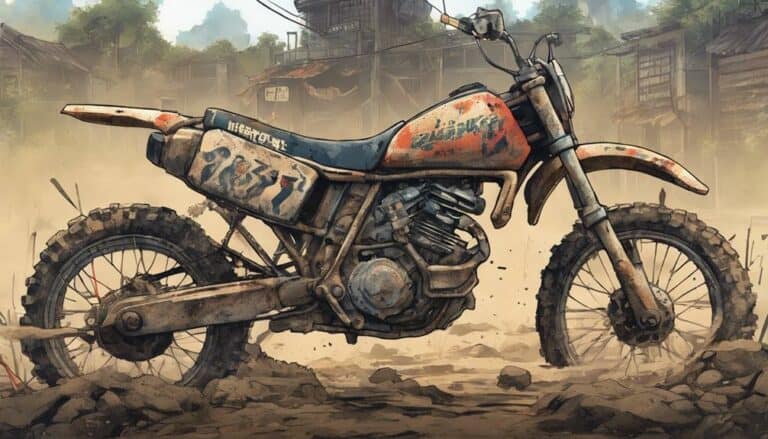When it comes to determining what constitutes high mileage for a dirt bike, it's not just about the numbers on the odometer. Factors like the type of terrain you ride on, the maintenance schedule you follow, and the overall care of your bike play important roles in defining high mileage for your machine.
So, before you make any decisions about your dirt bike's mileage, it's vital to take into account these factors that can greatly impact its longevity and performance.
Key Takeaways
- High mileage for a dirt bike is typically over 20,000 miles.
- Riders cover around 3,000 miles per year on average.
- Accumulate 50 to 200 hours of use annually.
- Proper maintenance and timely repairs are crucial for preventing wear and ensuring optimal performance.
Determining High Mileage for a Dirt Bike
Determining high mileage for a dirt bike primarily involves evaluating the accumulated usage in both miles and hours of operation. When evaluating the high mileage of a dirt bike, it's essential to take into account the years it has been used, the total miles traveled, and the hours the engine has been running.
High mileage for a dirt bike is typically classified as anything over 20,000 miles. Most dirt bikes cover an average of 3,000 miles per year with riders accumulating between 50 and 200 hours of use annually.
Manufacturers often recommend maintenance intervals based on both hours of operation and the total miles covered. It's important to understand that while high mileage is a factor, proper care and maintenance play a more significant role in determining a dirt bike's condition.
Factors Influencing Dirt Bike Mileage
Factors that influence dirt bike mileage range from riding conditions to maintenance practices. When considering the mileage of a dirt bike, it's essential to take into account the hours of use, maintenance intervals, activity level, and the overall condition of the bike. Proper maintenance plays a pivotal role in determining the longevity of a dirt bike. Manufacturers provide maintenance recommendations based on hours of use rather than just mileage to guarantee the bike functions at its best.
To better understand the factors influencing dirt bike mileage, consider the following table:
| Factors | Description | Importance |
|---|---|---|
| Hours of Use | Reflects rider activity and maintenance needs | High |
| Maintenance Intervals | Manufacturer's guidelines for upkeep | Critical |
| Activity Level | Frequency and intensity of riding | Significant |
| Condition of the Bike | Overall state of the dirt bike | Essential |
Signs of Wear in High Mileage Dirt Bikes
In high mileage dirt bikes, recognizing signs of wear is important to guarantee continued performance and safety on the trails. Here are three key signs to watch for:
- Worn-Out Components: Components such as the chain, sprockets, and brake pads may show excessive wear and tear in high mileage dirt bikes, affecting overall performance.
- Reduced Efficiency: High mileage can lead to reduced efficiency in a dirt bike, manifesting as decreased power output, lower fuel efficiency, and sluggish performance.
- Safety Hazards: Worn parts in high mileage dirt bikes pose safety hazards, including compromised braking ability, decreased handling, and potential mechanical failures on the trail.
Regular maintenance is important to address signs of wear promptly and prevent further damage to critical components of the dirt bike. By staying vigilant and addressing wear and tear early, you can make sure your high mileage dirt bike stays safe and performs optimally on your off-road adventures.
Extending the Lifespan of Your Dirt Bike
To maximize the longevity of your dirt bike, consistent and meticulous maintenance practices are paramount. Regular maintenance such as oil changes and air filter replacements aren't just essential tasks; they're vital for keeping your dirt bike running smoothly. By adhering to the manufacturer's maintenance schedule, you guarantee that important components are properly cared for.
Avoiding extreme riding conditions can also play a substantial role in extending the lifespan of your dirt bike. These conditions can accelerate wear and tear on various dirt bike components, leading to potential issues down the line. Proper storage is another key factor in preserving your dirt bike. Storing it in a dry, cool place helps prevent corrosion and other damage.
Additionally, using high-quality parts and conducting regular inspections for wear and tear can help maintain your dirt bike's performance over time. By following these practices, you can considerably increase the lifespan of your dirt bike and ensure many more enjoyable rides in the future.
Maintenance Tips for High-Mileage Dirt Bikes
Maximizing the lifespan of your dirt bike involves implementing specific maintenance strategies tailored for high-mileage usage. To prevent excessive wear and tear on components and guarantee peak performance, follow these maintenance tips:
- Regular Oil Changes: Consistent oil changes are important for high-mileage dirt bikes. Fresh oil lubricates the engine, reducing friction and preventing premature wear on important components.
- Air Filter Replacements: The air filter plays a significant role in protecting your engine from dirt and debris. Replace the air filter regularly to maintain ideal airflow and engine performance.
- Scheduled Inspections: Regular inspections of your high-mileage dirt bike can help catch potential issues early. Addressing any problems promptly can prevent further damage and extend the overall lifespan of your bike.
Conclusion
Now that you understand what constitutes high mileage for a dirt bike and the factors that influence it, remember that maintenance is key to extending its lifespan.
Just like a well-oiled machine, your dirt bike needs regular care and attention to keep running smoothly.
By staying on top of maintenance tasks and addressing any signs of wear early on, you can guarantee that your high-mileage dirt bike continues to perform at its best for years to come.

